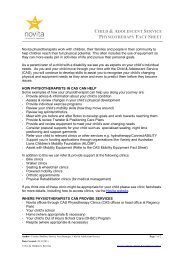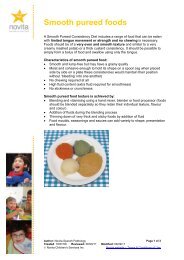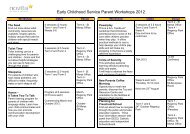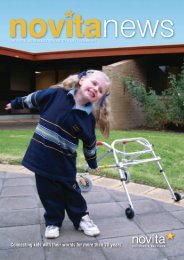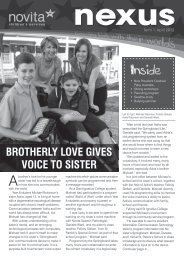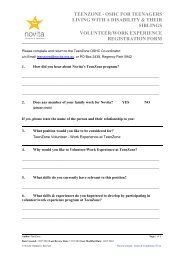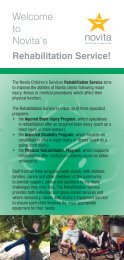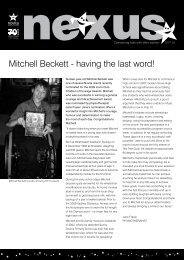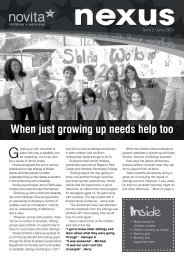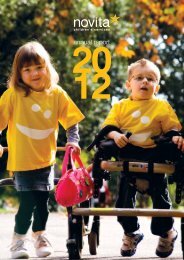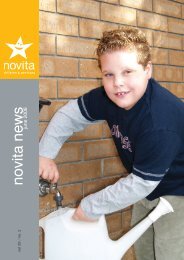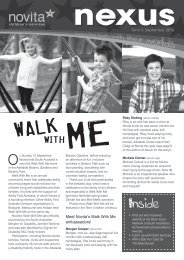Novita Research Report - 2004 to 2007 - Novita Children's Services
Novita Research Report - 2004 to 2007 - Novita Children's Services
Novita Research Report - 2004 to 2007 - Novita Children's Services
- No tags were found...
Create successful ePaper yourself
Turn your PDF publications into a flip-book with our unique Google optimized e-Paper software.
59Project titleContribu<strong>to</strong>rsSummaryTransporting kids and their wheelchairs – parents’ perceptionsHugh Stewart (University of South Australia), Dr Lloyd Walker, Meredith Frogley, LouiseDuBois, Chris Hern (Flinders University)The importance of independent mobility on the quality of life of children with disabilitieshas been recognised since the 1980’s and the rate of prescription of power wheelchairs forincreasingly younger children continues <strong>to</strong> grow (Wiart et al, 2003). However, a number ofparents and therapists at <strong>Novita</strong> reported that the process of finding and modifying a vehiclein which <strong>to</strong> transport children and their wheelchairs is problematic.Rehabilitation professionals like occupational therapists (OT) and physiotherapists (PT)are often the first people parents will ask for help once they recognise a transport problem.However, a study by Blake et al (2006) in the USA that involved surveying more than 1000rehabilitation therapists found that more than 50% reported little knowledge or experiencewith transport of children with special needs. Assuming the experience is similar in Australia,many therapists are then in the same position as the families, with limited knowledge andexperience of the problem.The aim of this study was <strong>to</strong> improve the process and resources available <strong>to</strong> families whowant <strong>to</strong> purchase a vehicle for their family, and <strong>to</strong> understand how <strong>Novita</strong> families have solvedthis problem in the past.MethodThe research questions were:1. Describe the vehicles and modifications used by parents <strong>to</strong> transport their children andwheelchairs.2. Describe the funding arrangements used <strong>to</strong> purchase the vehicle.3. What information would parents who have purchased a vehicle consider most importantfor parents wishing <strong>to</strong> buy a vehicle?A survey questionnaire was devised by three of the authors (based on their knowledge ofthe issue) <strong>to</strong> collect quantitative descriptive data and some qualitative data. It was reviewedby <strong>Novita</strong> OT and PT staff and appropriate changes were included in<strong>to</strong> the final survey. Anintroduc<strong>to</strong>ry cover sheet and the questionnaire with a post-paid return envelope were mailed<strong>to</strong> all parents of children who used a wheelchair in three of the five <strong>Novita</strong> regions. 358questionnaires were sent out and the responses were analysed by one of the research teamwho was independent of the initial survey construction.Results18% of questionnaires were returned and then grouped as follows based on the chair typeand use of a vehicle hoist: manual (53%), manual with hoist (21%), power (1%), power withhoist (11%), and both power and manual (14%). Most families with children in manual chairsat home, or able <strong>to</strong> transfer from their chair, used a regular car or station wagon. Once a childused a power chair at home the families needed <strong>to</strong> consider a van or other arrangement.Many families did not gain funding for the hoist and vehicle modifications due <strong>to</strong> either lackof knowledge, ineligibility or being unable <strong>to</strong> wait. A thematic analysis of the responsessuggested that other parents should obtain information in three main areas – informationabout their own child and family transport needs, information about vehicle features andoptions, and knowledge about the funding and purchasing process.




